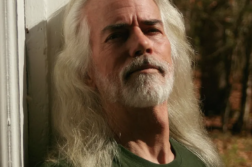FEW GLBT films in the past ten years have had the impact on independent filmmaking of Jonathan Caouette’s 2003 film, Tarnation. Made on a shoestring budget, Tarnation explored Caouette’s wildly unorthodox childhood as an openly gay kid growing up in Houston with his maternal grandparents, Rosemary and Adolph Davis, who were largely responsible for the schizophrenia of his mother, Renée Leblanc, after they submitted her for unnecessary shock therapy. There was no father in the picture.
Hailed as the first DIY (Do It Yourself) film of the new millennium, the experimental documentary was filled with materials that Caouette had collected since childhood—Super-8 home movies, answering machine messages, video diaries, parts of his early short films—was produced by Gus Van Sant and John Cameron Mitchell and received a U.S. theatrical release. Since then, Caouette has directed the 2009 documentary All Tomorrow’s Parties, which delves into the history of the cult music festival of that name, as well as an experimental short, “All Flowers in Time.”
At the age of five, Jonathan was on the streets of Chicago with his mother when he watched her being raped. Also in his early childhood he was abused and beaten while in foster care. When he was eight he started making artistic collages with available materials. His grandfather gave him a camera when he was eleven. At age twelve, a friend of his mom’s gave him a joint laced with formaldehyde and PCP, which lead to a trip to the hospital, where he was diagnosed with a dissociative disorder. During his teens, he began dressing like a girl and going to gay clubs; and he started making horror films starring himself, often dressed as a woman. In high school, where he was openly gay and had a boyfriend, he staged a musical version of David Lynch’s Blue Velvet.
After all those years of experience and personal filmmaking, the thirty-year-old Caouette put his tragic story out there with Tarnation, and the rest is his story. Now a father living in New York City with his boyfriend, Caouette sat down with me during this year’s Sundance Film Festival.
Gay & Lesbian Review: You’ve been collecting documentation of your life in the form of recordings and pictures since you were a child. What got you into that?
Jonathan Caouette: I was inspired by just watching television and staying up very late. During my formative years I was watching these very atmospheric horror films. That was the first genre I really liked. I was incredibly inspired by The Exorcist. Even the TV-edited version freaked me out. I saw the real version when I was about ten, and it blew my whole life away. When I was kid I would stare at myself or someone else under this really low lighting until it turned into something else. I’m still a diehard packrat. I haven’t succumbed to Netflix. I like the activity of going and looking for things physically. I still collect records. I’m one of those people who will go on Facebook and tell everyone how much I hate Facebook and how much I think it’s Videodrome.
GLR: Tell me about “All Flowers in Time.”
JC: Chloe Sevigny and I wanted to work together. We texted each other, she came over to my apartment, and we shot this thing. It became a 42-second film for the Onedreamrush project involving other directors like Kenneth Anger, David Lynch, and Harmony Korine. Then I built on it. I never anticipated it would be shown in film festivals. When people see it, it resonates with them on some subconscious level—maybe because it’s a compilation of my own nightmares as a kid.
GLR: You have been critical of the way Hollywood represents mental illness. Was this short film a response to that? I also thought it might be a fictionalized version of your past experiences.
JC: You’ve paraphrased the whole thing. You nailed it. A lot of this film stemmed from what I had grown up around in an arena of mental illness. Although this isn’t directly linked to mental illness, it is on some level. It’s definitely torn from the same world as a POV of somebody who may suffer from schizophrenia. I’m very interested in dreams, in dream logic and dream illogic. How do I get from here to there without using any typical linear means?
GLR: You also seem to suggest that there’s a playful way to deal with schizophrenia.
JC: Sure, even in 2011 mental illness is still very taboo. Nobody wants to talk about it. My next film, which I said I would never do, is my last documentary, and it’s a follow-up to Tarnation. It’s going to be a docu-hybrid, invoking a lot of magical realism and fantastical elements. I’m hoping we can pull it off in the way I’m seeing it.
GLR: One of the reasons you did not want to do a follow-up was because of the immense overexposure with Tarnation.
JC: With that said, there is going to be some overexposure again, but Walk Away Renee is going to be melded into a lot of fictionalized devices that we’re throwing in and that I’m going to be very upfront and blatant about. This is a docu-fiction film.
GLR: Do you think by embracing “disorders” in narrative you are resisting a patriarchal, Cartesian order?
JC: Absolutely. A great example of that is Roman Polanski’s Repulsion. My upcoming film is basically about an energy that was never born and that never dies. It doesn’t know how it got where it got, it just knows it needs to stay alive and it sort of synthesizes itself in an abstract TV show that looks like a 1970’s shampoo commercial, and it goes in and out of the television. It’s essentially a soul extractor, and its sole reason is to sustain its own existence. As the souls are removed, it allows these people to do these magical realist things themselves. My grandfather plays one of the people this energy invaded in the past. And that’s basically it.
GLR: Until recent times, homosexuality was officially considered a mental disorder.
JC: Sure was. Here’s my thing, I don’t think we should have gay pride marches anymore. I feel like we’re so in the future now we shouldn’t even be compartmentalized like that. Maybe it’s because I’m in New York and I’m in my own crazy bubble—although I am from Texas and I do go back there from time to time, and there’s still an undercurrent of homophobia.
GLR: Finally, what do you think of interviews in which you discuss yourself and your work? Does it serve the work? Should the work speak for itself?
JC: I don’t know. It’s weird because some authors write books about themselves, but the word “narcissism” never comes up in interviews with them, but with filmmakers it somehow does. I don’t understand that.
GLR: Do you read interviews of others?
JC: No, I don’t even watch television. I wish I did. I don’t even know who anybody is, and everybody kind of looks alike to me anyway, unfortunately. What happened to having normal looking people in movies? It’s like models in troubles.
GLR: “Models in troubles.” There is a title that writes its own show.
JC: It has been for awhile, but it’s now especially formulaic. What happened to the Sandy Dennises and Sissy Spaceks? Where do they fit in now?





